
Messier 100 is a grand design intermediate spiral galaxy in the southern part of the mildly northern Coma Berenices. It is one of the brightest and largest galaxies in the Virgo Cluster and is approximately 55 million light-years from our galaxy, its diameter being 107,000 light years, and being about 60% as large. It was discovered by Pierre Méchain in 1781 and 29 days later seen again and entered by Charles Messier in his catalogue "of nebulae and star clusters". It was one of the first spiral galaxies to be discovered, and was listed as one of fourteen spiral nebulae by Lord William Parsons of Rosse in 1850. NGC 4323 and NGC 4328 are satellite galaxies of M100; the former is connected with it by a bridge of luminous matter.

NGC 2608 is a barred spiral galaxy located 93 million light-years away in the constellation Cancer. It is 62,000 light-years across, and about 60% of the width of the Milky Way. It is considered a grand design spiral galaxy and is classified as SB(s)b, meaning that the galaxy's arms wind moderately around the prominent central bar.

NGC 3432 is an edge-on spiral galaxy that can be found in the northern constellation of Leo Minor. It was discovered by German-British astronomer William Herschel on March 19, 1787. This galaxy is located at a distance of 40 million light-years (12.3 Mpc) from the Milky Way. It is interacting with UGC 5983, a nearby dwarf galaxy, and features tidal filaments and intense star formation. Because of these features, it was listed in Halton Arp's Atlas of Peculiar Galaxies.

NGC 935 and IC 1801 are a pair of interacting galaxies within the Aries constellation. They were discovered on 18 September 1885 by Lewis Swift. NGC 935 is the northern member of the pair, and IC 1801 is the southern. Together, they are listed in Halton Arp's Atlas of Peculiar Galaxies as Arp 276, as an example of interacting galaxies.
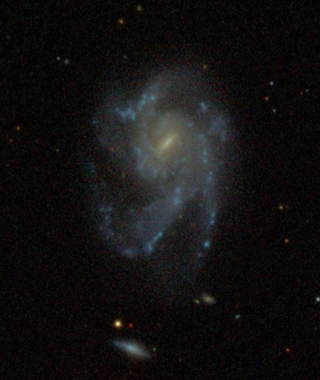
NGC 5579 is an intermediate spiral galaxy in the northern constellation of Boötes. It was discovered on May 1, 1785) by German-British astronomer William Herschel. The galaxy is located at a distance of 179 ± 14 million light-years (54.9 ± 4.3 Mpc) from the Milky Way, and is receding with a heliocentric radial velocity of 3,608 km/s. It is entry 69 in Halton Arp's Atlas of Peculiar Galaxies.
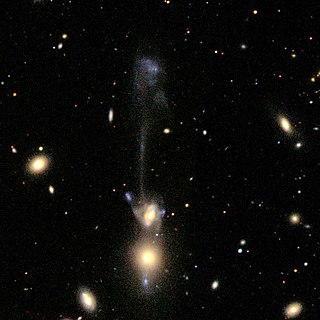
NGC 3561, also known as Arp 105, is a pair of interacting galaxies NGC 3561A and NGC 3561B within the galaxy cluster Abell 1185 in Ursa Major. It was discovered by British astronomer John Herschel on 30 March 1827. Its common name is "the Guitar" and contains a small tidal dwarf galaxy known as Ambartsumian's Knot that is believed to be the remnant of the extensive tidal tail pulled out of one of the galaxies.
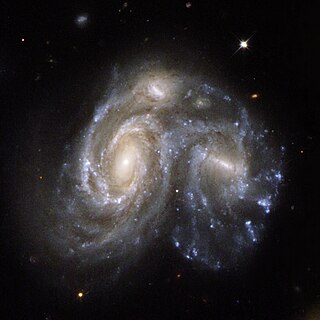
Arp 272 is a pair of interacting galaxies consisting of the two spiral galaxies NGC 6050 (left) and IC 1179 (right). Arp 272 lies around 450 million light years from Earth in the constellation of Hercules. The galaxies are part of the Hercules Cluster, which is itself part of the CfA2 Great Wall.
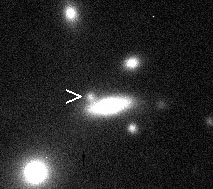
NGC 5177 is a lenticular galaxy. Based on a redshift of 6467 km/s the galaxy is crudely estimated to be about 300 million light-years away.
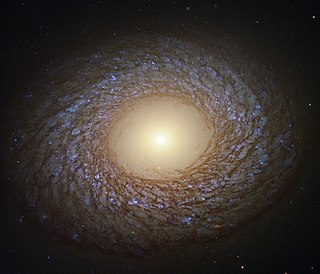
NGC 2775, also known as Caldwell 48, is a spiral galaxy in the constellation Cancer. It is 67 million light-years away from the Milky Way. It was discovered by William Herschel in 1783. NGC 2775 belongs to the Antlia-Hydra Cluster of galaxies and is the most prominent member of the NGC 2775 Group, a small galaxy group in the Virgo Super-cluster, along with the Local Group. Other members of the NGC 2775 Group include NGC 2777 and UGC 4781.

UGC 6945 is a trio of interacting galaxies. The highly disrupted galaxy to the northwest is actually two galaxies in the advanced stages of merger, and has an angular size of 0′.8 × 0′.6. About 40″ to the southeast is a third galaxy with an angular size of 0′.35 × 0′.35.

NGC 5584 is a barred spiral galaxy in the constellation Virgo. It was discovered July 27, 1881 by American astronomer E. E. Barnard. Distance determination using Cepheid variable measurements gives an estimate of 75 million light years, whereas the tip of the red-giant branch approach yields a distance of 73.4 million light years. It is receding with a heliocentric radial velocity of 1,637 km/s. It is a member of the Virgo III Groups, a series of galaxies and galaxy clusters strung out to the east of the Virgo Supercluster of galaxies.

NGC 5775 is a spiral galaxy, a member of the Virgo Cluster, that lies at a distance of about 70 million light-years. Although the spiral is tilted away from us, with only a thin sliver in view, such a perspective can be advantageous for astronomers. For instance, astronomers have previously used the high inclination of this spiral to study the properties of the halo of hot gas that is visible when the galaxy is observed at X-ray wavelengths. It is a member of the NGC 5775 Group of galaxies, itself one of the Virgo III Groups strung out to the east of the Virgo Supercluster of galaxies.

IC 755, also known as NGC 4019, is a barred spiral galaxy. It lies about 60 million light-years away in the northern constellation of Coma Berenices. It is a member of the Virgo Cluster.

NGC 210 is a barred spiral galaxy located roughly 67 million light-years from the Solar System in the constellation Cetus. It was discovered on October 3, 1785 by William Herschel and later added to the New General Catalogue.

NGC 3921 is an interacting galaxy in the northern constellation of Ursa Major. Estimates using redshift put it at about 59 million light years from Earth. It was discovered on 14 April 1789 by William Herschel, and was described as "pretty faint, small, round" by John Louis Emil Dreyer, the compiler of the New General Catalogue.

NGC 2300 is a lenticular galaxy in the constellation Cepheus. Its velocity with respect to the cosmic microwave background is 1876 ± 7 km/s, which corresponds to a Hubble distance of 90.2 ± 6.3 Mly (27.67 ± 1.94 Mpc). However, 11 non redshift measurements give a distance of 131.98 ± 21.75 Mly (40.464 ± 6.668 Mpc). The galaxy was discovered in 1871 by French astronomer Alphonse Borrelly using an 18 cm telescope.

NGC 4694 is a lenticular galaxy in the constellation Virgo. Its velocity with respect to the cosmic microwave background is 1481 ± 23 km/s, which corresponds to a Hubble distance of 71.3 ± 5.1 Mly (21.85 ± 1.57 Mpc). However, six non redshift measurements give a distance of 28.51 ± 7.23 Mly (8.742 ± 2.218 Mpc). The galaxy was discovered by William Herschel on March 15, 1784.

NGC 918 is a barred spiral galaxy in the constellation Aries, about 67 million light years from the Milky Way. It was discovered by John Herschel on Jan 11, 1831.

NGC 3799 is a barred spiral galaxy located in the constellation Leo. Its speed relative to the cosmic microwave background is 3,659 ± 24 km/s, which corresponds to a Hubble distance of 54.0 ± 3.8 Mpc. NGC 3799 was discovered by British astronomer John Herschel in 1832.

NGC 4246 is a spiral galaxy in the constellation of Virgo. Its velocity with respect to the cosmic microwave background is 4064 ± 24 km/s, which corresponds to a Hubble distance of 195.5 ± 13.7 Mly (59.94 ± 4.21 Mpc). However, 20 non-redshift measurements give a distance of 172.01 ± 10.57 Mly (52.740 ± 3.241 Mpc). It was discovered by German-British astronomer William Herschel on 13 April 1784. It was also observed by German astronomer Arnold Schwassmann on 30 October 1899 and listed in the Index Catalogue as IC 3113.























